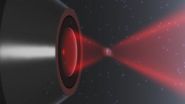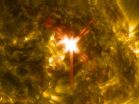(Press-News.org) Scientists from the University of Granada have taken part, alongside the Esteve laboratory, in the development of a new drug that multiplies the analgesic effect of opioids (drugs for treating intense pain), without increasing constipation, one of the most common side-effects of these drugs, among which is morphine.
This important scientific breakthrough has been published in The Journal of Pharmacology and Experimental Therapeutics, and has been chosen as its outstanding article in the month of January. So far, the University of Granada researchers have published the results from testing this molecule on mice.
Opium derivates have been used since ancient times to treat pain. Currently, these and similar products (opioids) are the drugs used to treat various types of intense pain, such as post-operatory pain, cancer pain or internal-organ pain. The prolonged use of opioids causes strong constipation, which is a substantial drawback to their administration, since it substantially diminishes patient well-being.
The recently-published article proves that S1RA, a drug that blocks the sigma-1 receptor, manages to multiply solely the beneficial effect of the opioids; that is, their pain-killing properties.
The sigma-1 receptor is a very small protein that acts as a neuro-modulator, physically linking to other proteins (among which are the opioid receptors) and modifying their function.
As Enrique Cobos del Moral, one of the authors and a researcher at the University of Granada Institute of Neuroscience, explains, opioids are basically "centrally-acting" drugs; that is, they act directly upon the brain and the spinal medula. However, when opioids are associated with sigma-1 receptor blockers, their pain-killing effects are brought about by acting upon other areas; specifically, on the peripheral nervous system. From this, it is deduced that the sigma-1 receptor is a biological brake that prevents peripheral opioid analgesia, and that this brake can be eliminated by pharmacological treatment so as to increase the pain-killing power of opioids.
This scientific breakthrough is of huge importance for the well-being of patients suffering from pain, since, in the short term, it will allow the development of more efficient painkillers with fewer side-effects.
Esteve is working on the development of this medication, which is currently in Clinical Phase II
INFORMATION:
References:
Modulation of Peripheral µ-Opioid Analgesia by sigma1 Receptors
Sánchez-Fernández C, Montilla-García Á, González-Cano R, Nieto FR, Romero L, Artacho-Cordón A, Montes R, Fernández-Pastor B, Merlos M, Baeyens JM, Entrena JM, Cobos EJ.
The Journal of Pharmacology and Experimental Therapeutics. 348:32, January 2014
http://dx.doi.org/10.1124/jpet.113.208272
Tested a drug that strengthens the analgesic effect of opioids without increasing constipation
Researchers from the University of Granada publish the results of this new drug, tested on mice
2014-03-31
ELSE PRESS RELEASES FROM THIS DATE:
Researchers develop device that simulates gastro-intestinal tract
2014-03-31
A breakthrough in drug testing developed by a University of Huddersfield lecturer could lead to cheaper, more effective medicines. Dr Hamid Merchant is a member of the team that has created a device which accurately simulates the gastro-intestinal tract and how it absorbs medication. This means that the cost of clinical trials could be greatly reduced, with savings passed on to customers.
Dr Merchant has joined the University as a Senior Lecturer in Pharmaceutics. Previously a postdoctoral fellow at University College London (UCL), he has extensive research experience, ...
Certain genetic variants may identify patients at higher risk of bladder cancer recurrence
2014-03-31
While patients diagnosed with bladder cancer usually face a favorable prognosis, many experience recurrence after treatment. Because frequent, painful screenings are needed to identify recurrences, the ablility to identify patients at high risk of recurrent cancer could help to improve quality of life for all bladder cancer patients.
A new study published in BJU International, "Genetic polymorphisms modify bladder cancer recurrence and survival in a U.S. population-based prognostic study," suggests that certain inherited DNA sequences may affect a bladder cancer patient's ...
Heparin more effective than bivalirudin in patients during emergency heart procedure
2014-03-31
WASHINGTON (March 31, 2014) — In a comparison of two blood-thinning medications, heparin was associated with significantly fewer major cardiovascular events at 28 days than bivalirudin in patients receiving primary percutaneous coronary intervention after a heart attack, according to research presented at the American College of Cardiology's 63rd Annual Scientific Session.
The single-center, open label trial enrolled 1,829 patients with suspected heart attack who received a coronary angiography, an imaging test to see how blood flows through the heart. Patients were randomized ...
Anti-anxiety drugs and sleeping pills linked to risk of death
2014-03-31
Anti-anxiety drugs and sleeping pills have been linked to an increased risk of death, according to new research from the University of Warwick.
The large study, published in BMJ, shows that several anxiolytic (anti-anxiety) drugs or hypnotic drugs (sleeping pills) are associated with a doubling in the risk of mortality.
Although these findings are based on routine data and need to be interpreted cautiously, the researchers recommended that a greater understanding of their impact is essential.
Professor Scott Weich, Professor of
Psychiatry at the University of ...
Drug-eluting stents demonstrate better outcomes after 1 year than bare metal stents
2014-03-31
WASHINGTON (March 31, 2014) — Use of drug-eluting stents is associated with a lower risk of major cardiovascular events at one year compared to bare metal stents when followed by an individualized course of blood-thinning medication among patients previously thought to be uncertain candidates for drug-eluting stents due to their heightened risk of bleeding or blood clots, according to research presented at the American College of Cardiology's 63rd Annual Scientific Session.
Positive study findings for patients receiving a shorter than currently recommended course of ...
Never say never in the nano-world
2014-03-31
This news release is available in German.
Objects with sizes in the nanometer range, such as the molecular building blocks of living cells or nanotechnological devices, are continuously exposed to random collisions with surrounding molecules. In such fluctuating environments the fundamental laws of thermodynamics that govern our macroscopic world need to be rewritten. An international team of researchers from Barcelona, Zurich and Vienna found that a nanoparticle trapped with laser light temporarily violates the famous second law of thermodynamics, something that ...
New human trial shows stem cells are effective for failing hearts
2014-03-31
WASHINGTON (March 31, 2014) — Patients with severe ischemic heart disease and heart failure can benefit from a new treatment in which stem cells found in bone marrow are injected directly into the heart muscle, according to research presented at the American College of Cardiology's 63rd Annual Scientific Session.
"Our results show that this stem cell treatment is safe and it improves heart function when compared to placebo," said Anders Bruun Mathiasen, M.D., research fellow in the Cardiac Catherization Lab at Rigshospitalet University Hospital Copenhagen, and lead investigator ...
Real-world heart procedure results consistent with scientific research
2014-03-31
WASHINGTON (March 31, 2014) — The first one-year outcomes data of transcatheter heart valve replacement (TAVR) in nearly all U.S. patients undergoing this procedure shows that real-world outcomes are comparable to or slightly better than those found in clinical trials, according to registry data presented at the American College of Cardiology's 63rd Annual Scientific Session. However, specific baseline characteristics of patients undergoing TAVR are associated with differing degrees of death and survival and may be important considerations for patient counseling and shared ...
Newly discovered molecule may offer hope for immune disorders and runaway inflammation
2014-03-31
A new research discovery published in the April 2014 issue of the Journal of Leukocyte Biology may open the door to new therapies that help treat immune disorders or curb runaway inflammation. Specifically, scientists have discovered a molecule that can induce cell death (apoptosis) in a key type of immune cell (dendritic cells). With this understanding, it may be possible to develop new therapies that essentially shut down dendritic cell activity, and thereby reducing an immune reaction.
"We hope that our findings provide better understanding of immune regulation, which ...
NASA releases images of X-class solar flare
2014-03-31
The sun emitted a significant solar flare, peaking at 1:48 p.m. EDT March 29, 2014, and NASA's Solar Dynamics Observatory captured images of the event. Solar flares are powerful bursts of radiation. Harmful radiation from a flare cannot pass through Earth's atmosphere to physically affect humans on the ground, however -- when intense enough -- they can disturb the atmosphere in the layer where GPS and communications signals travel.
To see how this event impacted Earth, please visit NOAA's Space Weather Prediction Center at http://spaceweather.gov, the U.S. government's ...
LAST 30 PRESS RELEASES:
Why nail-biting, procrastination and other self-sabotaging behaviors are rooted in survival instincts
Regional variations in mechanical properties of porcine leptomeninges
Artificial empathy in therapy and healthcare: advancements in interpersonal interaction technologies
Why some brains switch gears more efficiently than others
UVA’s Jundong Li wins ICDM’S 2025 Tao Li Award for data mining, machine learning
UVA’s low-power, high-performance computer power player Mircea Stan earns National Academy of Inventors fellowship
Not playing by the rules: USU researcher explores filamentous algae dynamics in rivers
Do our body clocks influence our risk of dementia?
Anthropologists offer new evidence of bipedalism in long-debated fossil discovery
Safer receipt paper from wood
Dosage-sensitive genes suggest no whole-genome duplications in ancestral angiosperm
First ancient human herpesvirus genomes document their deep history with humans
Why Some Bacteria Survive Antibiotics and How to Stop Them - New study reveals that bacteria can survive antibiotic treatment through two fundamentally different “shutdown modes”
UCLA study links scar healing to dangerous placenta condition
CHANGE-seq-BE finds off-target changes in the genome from base editors
The Journal of Nuclear Medicine Ahead-of-Print Tip Sheet: January 2, 2026
Delayed or absent first dose of measles, mumps, and rubella vaccination
Trends in US preterm birth rates by household income and race and ethnicity
Study identifies potential biomarker linked to progression and brain inflammation in multiple sclerosis
Many mothers in Norway do not show up for postnatal check-ups
Researchers want to find out why quick clay is so unstable
Superradiant spins show teamwork at the quantum scale
Cleveland Clinic Research links tumor bacteria to immunotherapy resistance in head and neck cancer
First Editorial of 2026: Resisting AI slop
Joint ground- and space-based observations reveal Saturn-mass rogue planet
Inheritable genetic variant offers protection against blood cancer risk and progression
Pigs settled Pacific islands alongside early human voyagers
A Coral reef’s daily pulse reshapes microbes in surrounding waters
EAST Tokamak experiments exceed plasma density limit, offering new approach to fusion ignition
Groundbreaking discovery reveals Africa’s oldest cremation pyre and complex ritual practices
[Press-News.org] Tested a drug that strengthens the analgesic effect of opioids without increasing constipationResearchers from the University of Granada publish the results of this new drug, tested on mice



